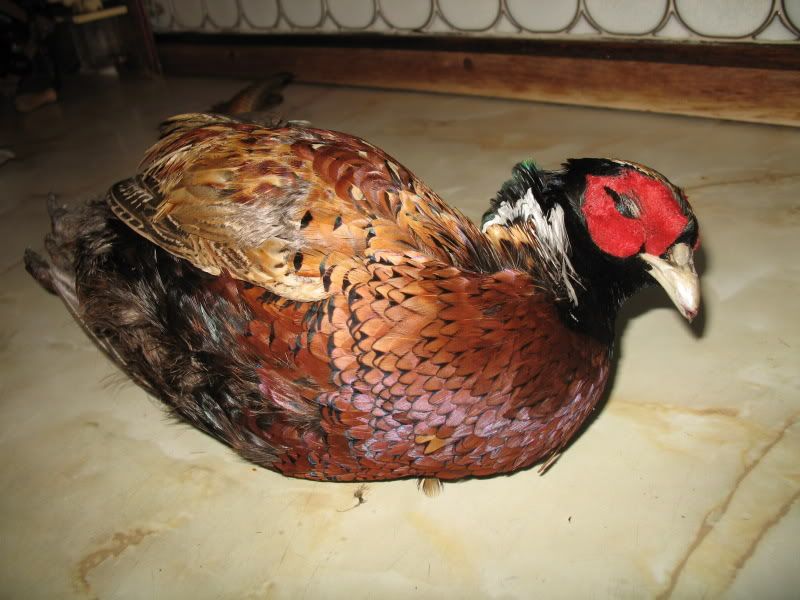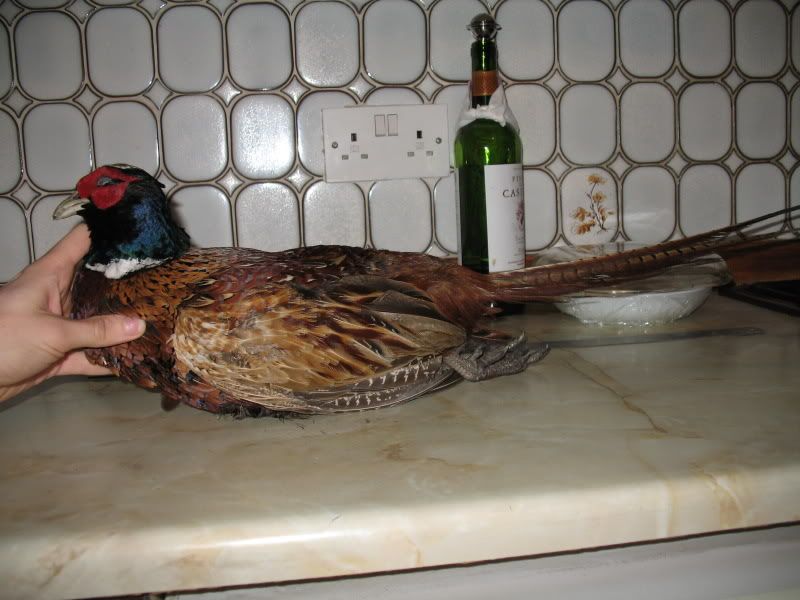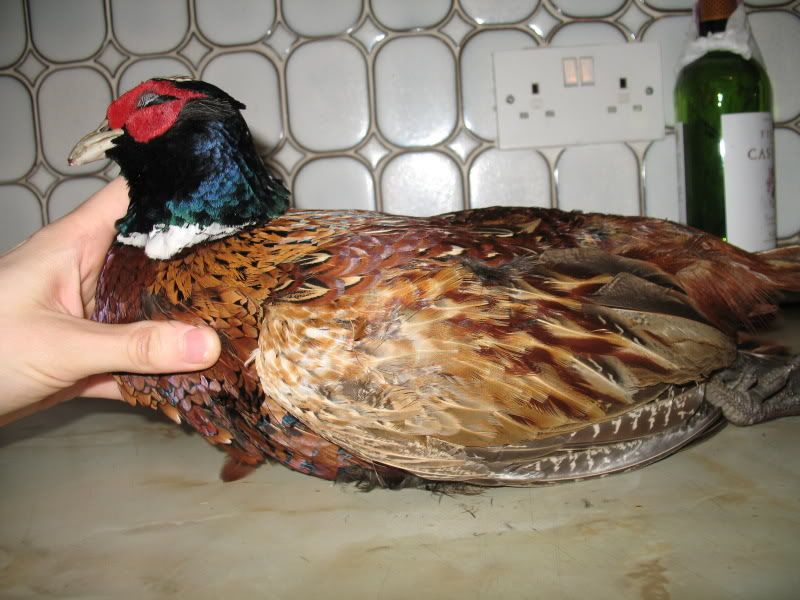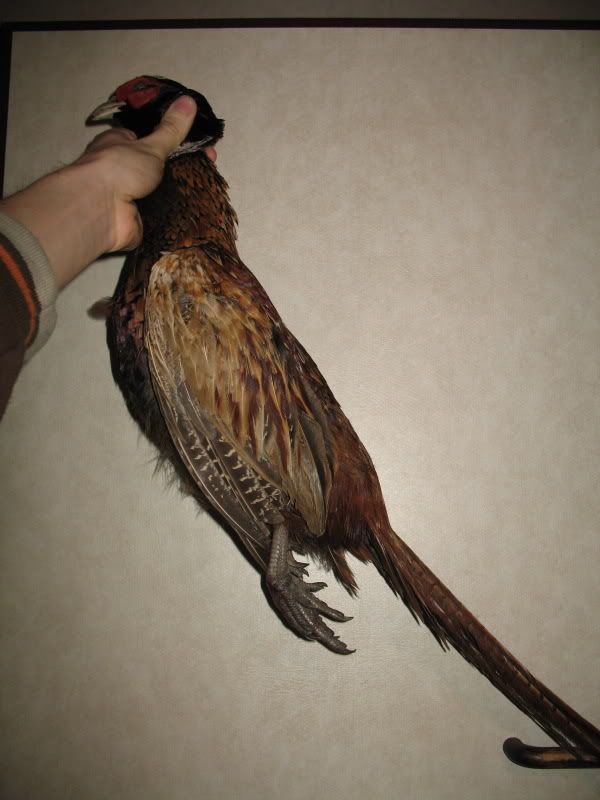Hi folks.
Today I was given a roadkill pheasant (a cock) and I'm looking for advice on what to do with it.
As far as I know it was picked off the road very soon after being hit, the blood was still runny and when I took it out of the carrier bag it'd been put in, it was still slightly warm, so "fresh".
His wingspan is about 30 inches. (Roughly 13 inches from shoulder to wingtip).
Now, I've never eaten pheasant, and this will be the first animal I butcher.
I've seen Kill it, Cook it, Eat it... but that's about all the experience I have. (That'd be "none" then)
I've got a few questions.
I understand younger birds have a "bursa" just above the anal vent and older ones don't, but I've no idea what either are meant to look like. It's a fairly big bird though so I'm guessing it's an older one.
Is there something that can show me how to find the bursa to see if it's young or old?
Whether it is young or old, what's a good way to cook it for a first time taste?
(For the record, I'm not going to be hanging it for ages. I know it's meant to "improve" the meat in some way, but I've not quite squared away the idea of eating part rotten meat yet so will probably have it quite fresh)
When I paunch it, what am I looking for to check it's not got anything nasty that should stop me eating it?
Other than being dead, it looks like a healthy animal from the outside, bright colours and lovely plumage.
In a PM exchange with Toddy, she said it'd be worth checking the bowel hasn't burst in the impact (I imagine a ton of 60mph steel would do a fair bit of damage - poor thing) - is it really obvious what's what in there? Having never seen inside an animal in person before I'm not entirely sure what to look for, though I remember a fair bit from GCSE biology.
When I gut it, is there any part worth keeping for any other use (food or otherwise)?
The crop feels like there's something in there (though I've never felt one before so I'm only going on what I expect, not experience). How much does the bird's diet matter? I don't expect to see the kind of muck an urban pigeon would have eaten, but is there anything that should be off-putting in there?
Here follow some pictures to help you age the bird and just share in the beauty of it. It's always such a shame to see such lovely creatures killed on the roads - it was a pretty fast road though, and being found so fresh in the middle of the road probably suggests a quick death, which is a plus.
I didn't get around to taking shots in daylight so it's all with flash, the full colour of the feathers hasn't come out, but it looks lovely in the sunlight.






Not the best shots I've ever taken, but I couldn't get him to pose on command so I had to use one hand while trying to shoot what I wanted, not the easiest thing to do.
If you have any suggestions on non-food use for other bits of the bird please let me know.
Cheers folks.
Today I was given a roadkill pheasant (a cock) and I'm looking for advice on what to do with it.
As far as I know it was picked off the road very soon after being hit, the blood was still runny and when I took it out of the carrier bag it'd been put in, it was still slightly warm, so "fresh".
His wingspan is about 30 inches. (Roughly 13 inches from shoulder to wingtip).
Now, I've never eaten pheasant, and this will be the first animal I butcher.
I've seen Kill it, Cook it, Eat it... but that's about all the experience I have. (That'd be "none" then)
I've got a few questions.
I understand younger birds have a "bursa" just above the anal vent and older ones don't, but I've no idea what either are meant to look like. It's a fairly big bird though so I'm guessing it's an older one.
Is there something that can show me how to find the bursa to see if it's young or old?
Whether it is young or old, what's a good way to cook it for a first time taste?
(For the record, I'm not going to be hanging it for ages. I know it's meant to "improve" the meat in some way, but I've not quite squared away the idea of eating part rotten meat yet so will probably have it quite fresh)
When I paunch it, what am I looking for to check it's not got anything nasty that should stop me eating it?
Other than being dead, it looks like a healthy animal from the outside, bright colours and lovely plumage.
In a PM exchange with Toddy, she said it'd be worth checking the bowel hasn't burst in the impact (I imagine a ton of 60mph steel would do a fair bit of damage - poor thing) - is it really obvious what's what in there? Having never seen inside an animal in person before I'm not entirely sure what to look for, though I remember a fair bit from GCSE biology.
When I gut it, is there any part worth keeping for any other use (food or otherwise)?
The crop feels like there's something in there (though I've never felt one before so I'm only going on what I expect, not experience). How much does the bird's diet matter? I don't expect to see the kind of muck an urban pigeon would have eaten, but is there anything that should be off-putting in there?
Here follow some pictures to help you age the bird and just share in the beauty of it. It's always such a shame to see such lovely creatures killed on the roads - it was a pretty fast road though, and being found so fresh in the middle of the road probably suggests a quick death, which is a plus.
I didn't get around to taking shots in daylight so it's all with flash, the full colour of the feathers hasn't come out, but it looks lovely in the sunlight.






Not the best shots I've ever taken, but I couldn't get him to pose on command so I had to use one hand while trying to shoot what I wanted, not the easiest thing to do.
If you have any suggestions on non-food use for other bits of the bird please let me know.
Cheers folks.
